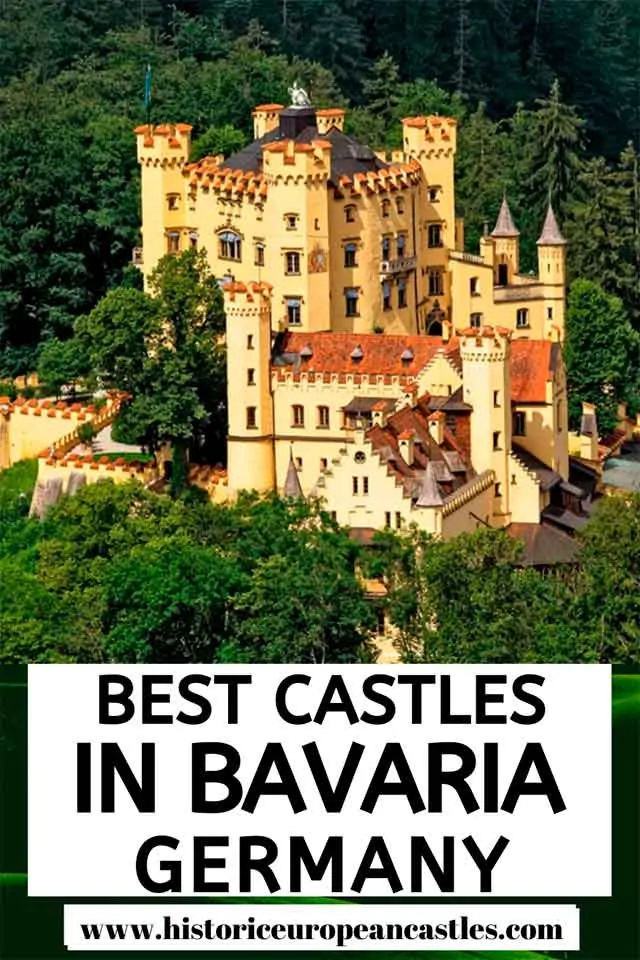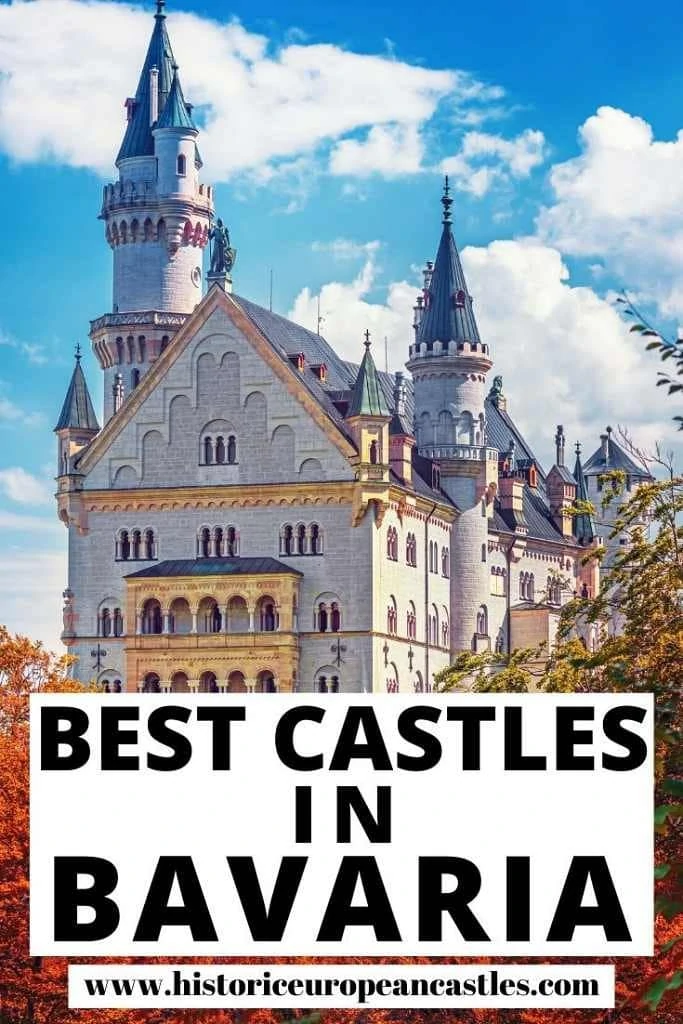One of the most important historic regions of Germany, Bavaria is home to dozens of spectacular medieval fortresses, sumptuous palaces, and eclectic castles. Steeped in history and legend and set in areas of gorgeous natural beauty, these places have inspired imaginations all over the world.
Many sit perched high above historic little towns as they have for centuries, others are nestled deep in remote forests. All, however, brim with magical charm and have their intriguing history.
This is a list of the best Bavarian castles to visit if you want to experience these enchanting lands.
Map of Castles in Bavaria

Where to Stay in Bavaria There are many beautiful hotels in Bavaria where you can base yourself and book a rental car so you can explore these incredible castles at your own pace. Hotel zum Erdinger Weissbräu: Located in the heart of the Bavarian town of Erding, this historic hotel dates back to 1537 and retains its classic Gothic style. The banquet hall retains its characteristic chandeliers and wooden panelling, and the on-site brewery keeps the traditional German beer cellar well-stocked. Book your stay here. Floating Village Brombachsee: Looking for something unique? This 4-star holiday resort close to Ellingen Castle is a collection of 2-bedroom boats with living rooms and spectacular views from your deck and roof terrace equipped with lounge furniture. Breakfast is brought to you by boat each morning, or you can enjoy your own using your kitchen. Each bungalow has its own parking space. You then take a riverboat to your bungalow. Book your stay here. Burghotel: This 12th-century hotel in the Tauber Valley is on the edge of the Medieval town of Rothenburg and has a spa and rose garden for guests to enjoy. There is also an onsite Dominican monastery to visit. Each room is individually designed, including views of the Tauber valley. Meals are served on the terrace or the bright dining room with uninterrupted views of the surrounding countryside. Book your stay here. AMERON Neuschwanstein Alpsee Resort & Spa: Located next to Neuschwanstein Castle and Hohenschwangau Castle, the hotel rooms and the spa area offer views of the stunning Alpsee lake, the Alps, and the stunning castles. Book your stay here. How to Get Around Bavaria The best way to visit the castles in Bavaria is by car, as some of them are located in secluded areas. I recommend booking a car through Discover Cars, where you can compare all rental car agencies’ prices, and you can cancel or modify your booking for free. They also guarantee the best price. Click here for more information and to check the latest prices. You can also book a tour from Munich to enjoy the beautiful castles Neuschwanstein, Hohenschwangau, and Linderhof Palace. Click here for more information, availability, and the latest prices. If you want to visit Herrenchiemsee Palace, you can book a tour from Munich as well. Click here for more information and the latest prices. Alternatively, you can take the train to visit some of the castles. Click here for more information on train tickets.
32 Bavarian Castles to Visit
1. Burghausen Castle
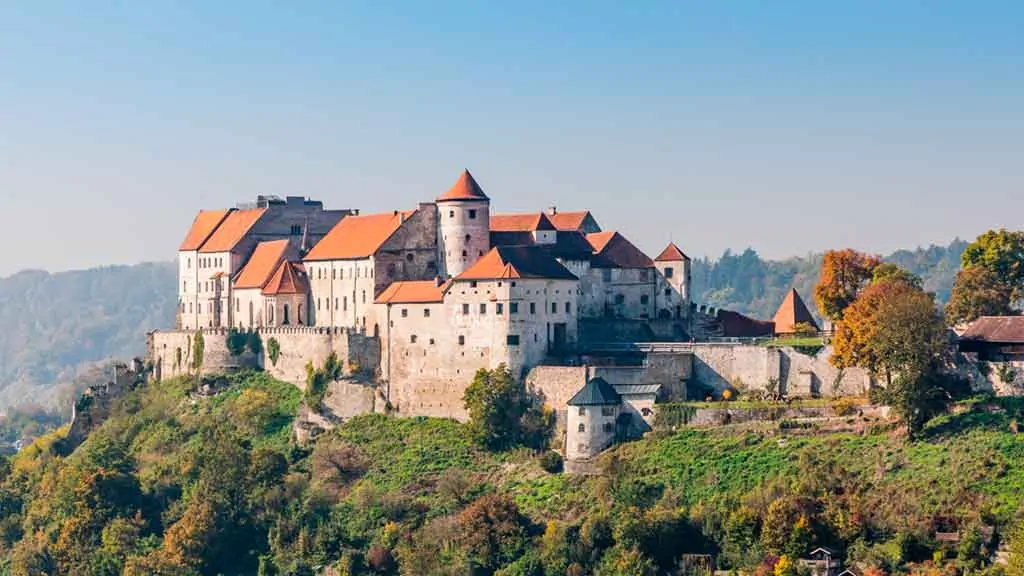
With a length of more than one million meters, Burghausen Castle is the largest castle in the world and one of the most impressive sights in Bavaria.
Besides its outstanding dimension, this castle has existed through centuries of tumultuous history, to which the original medieval fortifications are a testament.
Drawbridges, moats, and portcullises have remained almost completely in their original form, while the interior is an exquisite example of Art Nouveau.
Interestingly, a castle has existed in the same location ever since the Bronze Age.
Where: Burghausen, Upper Bavaria
When: 13th-century
Style: Medieval
Open to visit: Yes. Check here for more information.
2. Hohenschwangau Castle
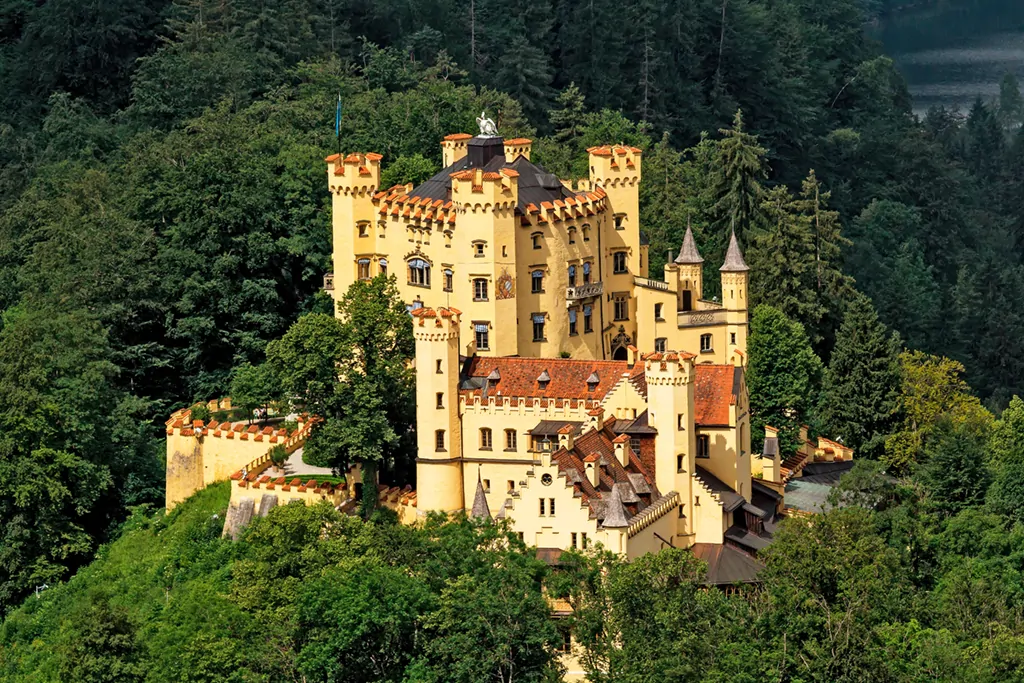
Located near the famous Neuschwanstein Castle, Hohenschwangau was once as glamorous as the latter.
Although in ruins for a long while, the castle was restored by King Maximilian II of Bavaria and transformed into a summer residence.
This romantic Gothic castle is nestled in a beautiful green valley with amazing views over the Alps. The interior includes charming royal bedrooms, ballrooms, and salons.
The walls of the castle are adorned with paintings representing Germanic folktales and historical legends.
Where: town of Füssen, Southern Bavaria
When: 19th-century
Style: Gothic
Open for visit: Yes, check here for more information.
Check out: The best Castles near Munich.
3. Johannisburg Castle

Located by the River Main, Johannisburg Castle was built in the place of an earlier medieval castle at the beginning of the 17th century to serve as a residence for Archbishop-Elector Johann Schweikard von Kronberg.
The castle is a stunning example of palace architecture pertaining to the German Renaissance style. In the 18th century, the interior was redecorated in the Neoclassical style.
Johannisburg Castle suffered extensive damage during the Second World War, but thankfully art collections and furnishings were preserved, and the castle was opened to visitors in the latter half of the 20th century.
Where: town of Aschaffenburg, Franconia
When: 17th-century
Style: German Renaissance/ Neoclassical
Open for visit: Yes. Check here for more information.
4. Neuschwanstein Castle
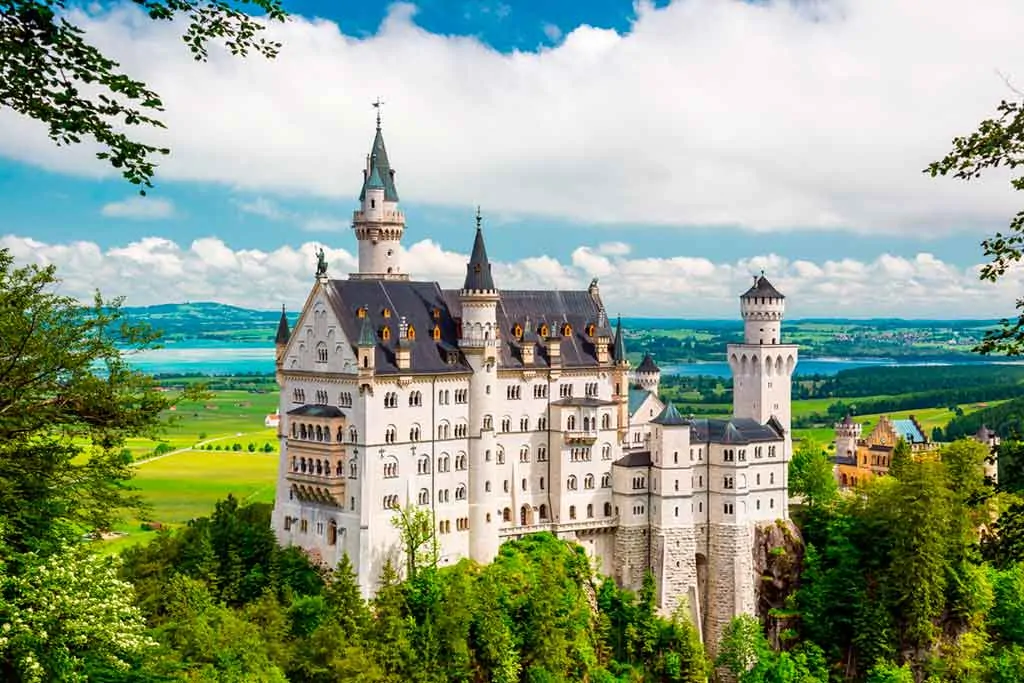
The 19th-century Neuschwanstein Castle is arguably the quintessential Bavarian castle. Nestled in the Alps with views over the Hohenschwangau Valley, this idyllic castle was built for King Ludwig II as a luxurious refuge in the mountains.
The castle seems taken straight out of a fairy tale, and it is, in fact, the place that inspired the iconic Disney castle from Sleeping Beauty and the actual castle from Disneyland.
With its turrets, dark dungeons, and sweeping location, Neuschwanstein Castle is an outstanding example of a Romantic castle.
Where: town of Fussen, Southern Bavaria
When: 19th-century
Style: Romanesque
Open for visit: Yes. Check here for more information.
You might also like to read: The best castles to visit in Germany.
5. Nuremberg Castle
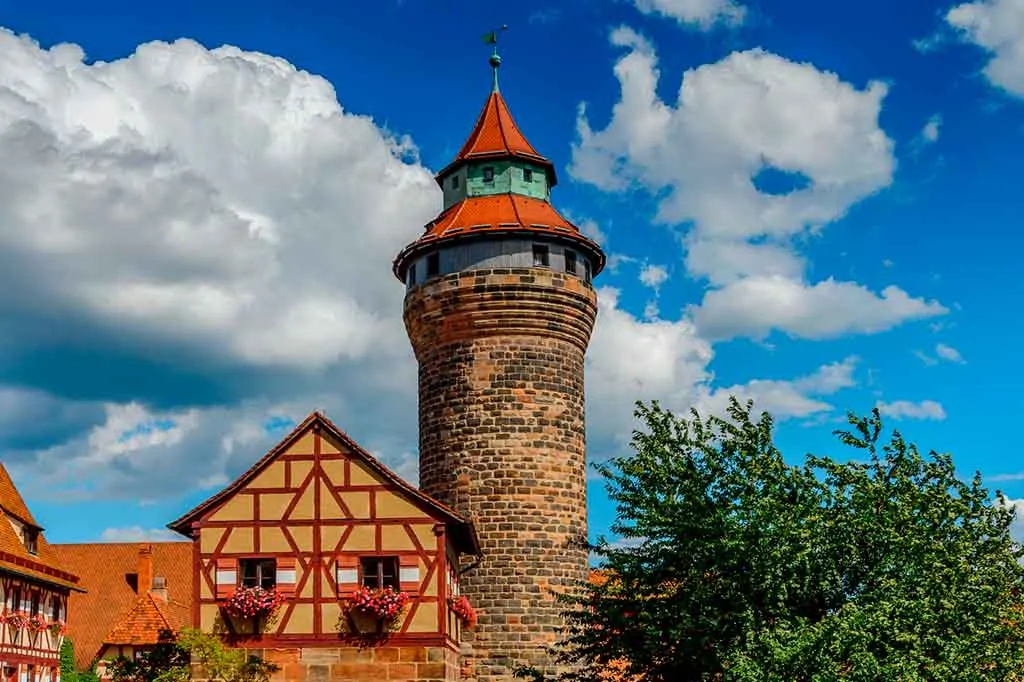
Although not exactly opulent, Nuremberg Castle is a historic castle that has been standing over the Bavarian city of Nuremberg ever since the 12th century.
A significant monument of the Middle Ages, this castle was also a residence for the emperors of the Holy Roman Empire and features a unique Romanesque chapel and beautiful halls and courtyards. Inside the castle, there is also a museum of medieval weapons and military artifacts.
A great symbol of the city, Nuremberg Castle also offers sweeping views of the area.
Where: Nuremberg
When: 12th-century
Style: Medieval
Open for visit: Yes. Check here for more information.
6. Wurzburg Residenz
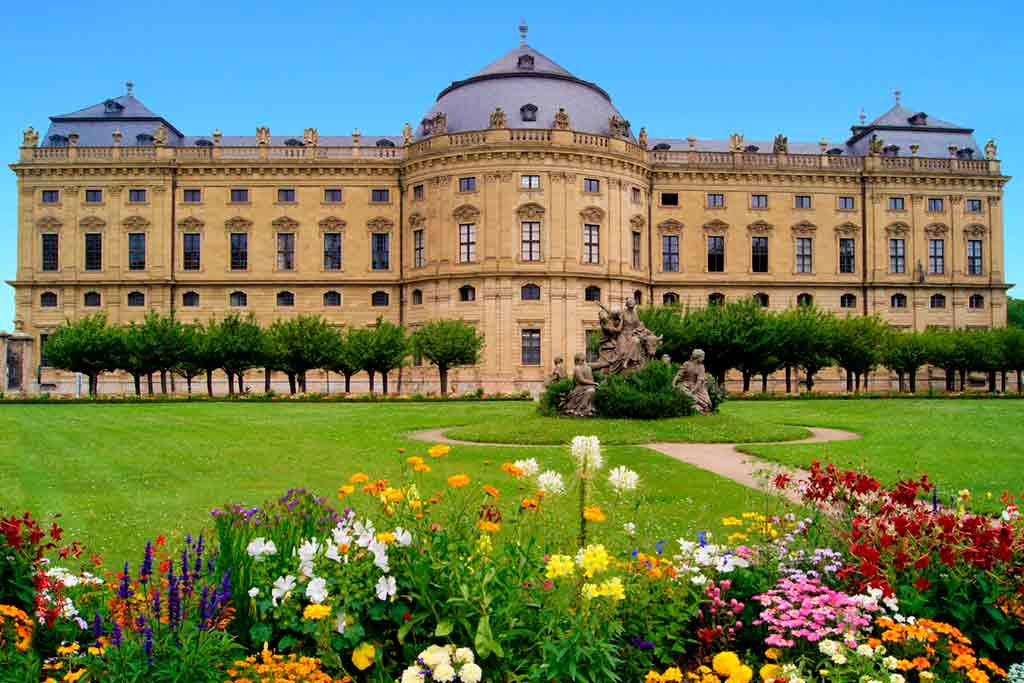
Wurzburg Castle is the former residence of the prince-bishops of Wurzburg. Now considered one of the most stunning Baroque palaces in Europe, it took sixty years to be built, from 1720 to 1780.
The castle features a world-famous staircase with a ceiling painted by Venetian artist Giovanni Battista Tiepolo. Representing the four continents, this is one of the largest frescoes in the history of painting.
The Garden Hall, White Hall, and Imperial Hall are also adorned with magnificent frescos.
Unfortunately, a devastating fire destroyed parts of the castle in 1945, but a long process of restoration brought it back to its former glory.
Where: Wurzburg
When: 18th-century
Style: Baroque
Open to visit: Yes, check here for more information.
7. Blutenburg Castle

Right outside of Munich, Blutenburg Castle is situated in an area of lush vegetation. This beautiful castle was built by Duke Albert III in the 15th century to replace an older castle.
Used primarily as a luxurious hunting lodge, the castle offers stunning views of the Wurm River and the surrounding area. Although the interior cannot be visited, the castle is worth a visit for the charming rural beauty of the region.
Where: Seldwed 15, west of Munich
When: 15th-century
Style: Medieval
Open for visit: Yes, only the chapel. Check here for more information.
8. Brennhausen

Located in the Haßberge Nature Park, Brennhausen Castle dates back to the 12th century, as suggested by an official document from 1182.
The castle belonged initially to a family of noblemen but changed hands frequently throughout the centuries. Sometimes it was sold; other times conquered by siege.
Due to the strategic location of the castle, many influential Bavarian political and military figures resided in it over the years. An old tradition says that Brennhausen was originally a monastery.
Where: Sulzdorf, the district of Rhön-Grabfeld
When: 12th-century
Style: Early Medieval
Open to visit: No.
9. Callenberg Castle
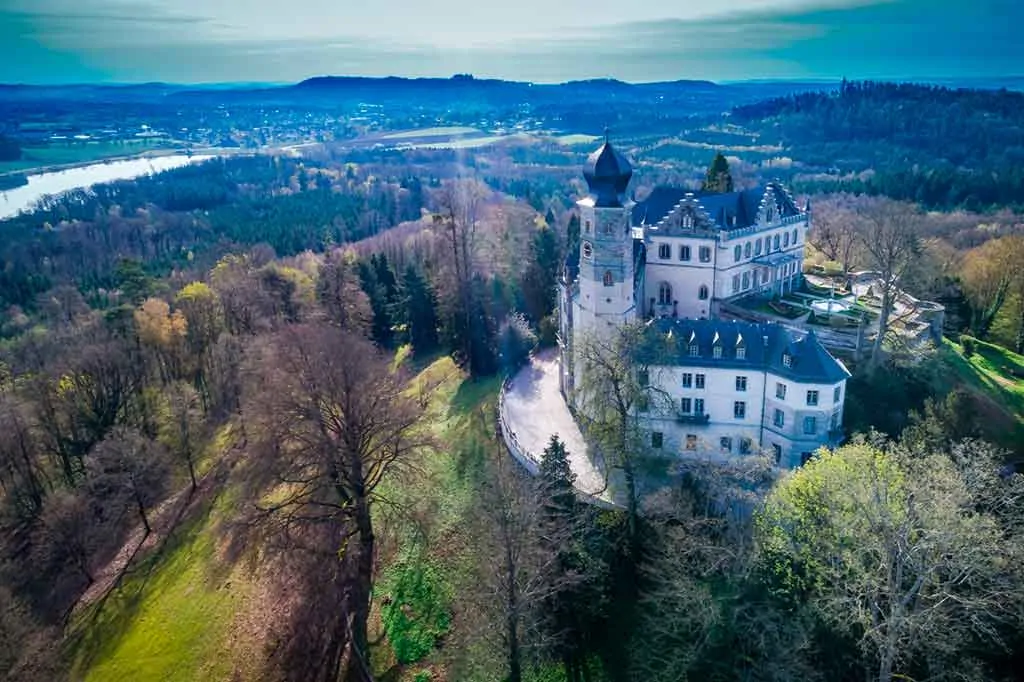
Located northeast of Coburg, Callenberg Castle was one of the main residences of the Dukes of Coburg and has been in possession of the Saxe-Coburg family for many centuries.
The long history of the castle is reflected in the diversity of architectural and stylistic details visible today, which can be traced back to various eras and generations of dukes.
Some of the highlights of the castle are the “Royal Roses,” which bloom in the summer, and the collection of ducal art treasures, including valuable pieces of furniture, porcelain, paintings, and weaponry.
Where: Coburg
When: 12th-century
Style: Early Medieval
Open to visit: Yes, check here for more information.
10. Eisenberg Castle
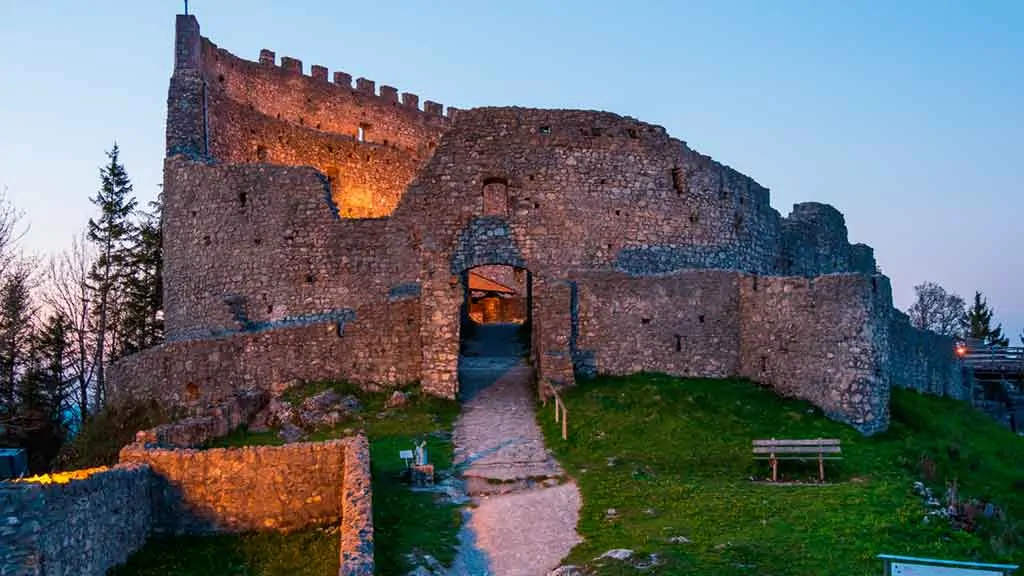
Located on a hilltop north of Pfronten, Eisenberg is a medieval castle that is now in ruins. Built in 1313 by the noble family of Hohenegg, the castle was meant to become the new seat of the lordship of Eisenberg.
To that end, the castle was built with grandness in mind, starting from its location on top of a high mountain.
The castle was fortified with a high curtain wall to resist attacks, but in 1646, the owners burned it down during the Thirty Years’War to avoid letting it be captured by the enemy.
Where: Eisenberg, north of Pfronten
When: 14th-century
Style: Medieval
Open to visit: No restrictions.
Tickets: –
11. Giechburg
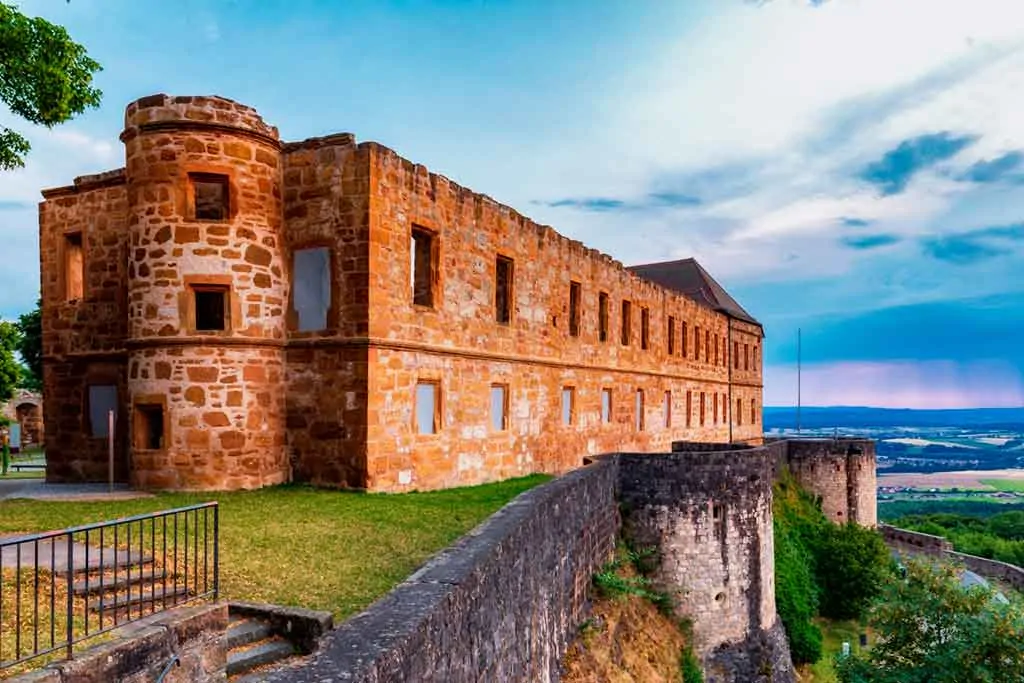
Giechburg Castle is a hilltop castle that entered written history as early as 1125, although archaeological evidence suggests a fortified structure existed in the same spot ever since Neolithic times.
Over the centuries, the castle changed owners frequently but at the end of the 14th century, it was purchased by the prince-bishops of Bamberg, who expanded it further and gave it its final form as a fortified medieval castle and later hunting lodge.
The castle was neglected in the 19th century and became a ruin. After being reconstructed by the district of Bamberg in the last couple of decades, Giechburg Castle now functions as a conference and hospitality center.
Where: city district of Scheßlitz, Upper Franconia
When: 12th-century
Style: Medieval fortress
Open to visit: No, restrictions.
12. Lauf Castle
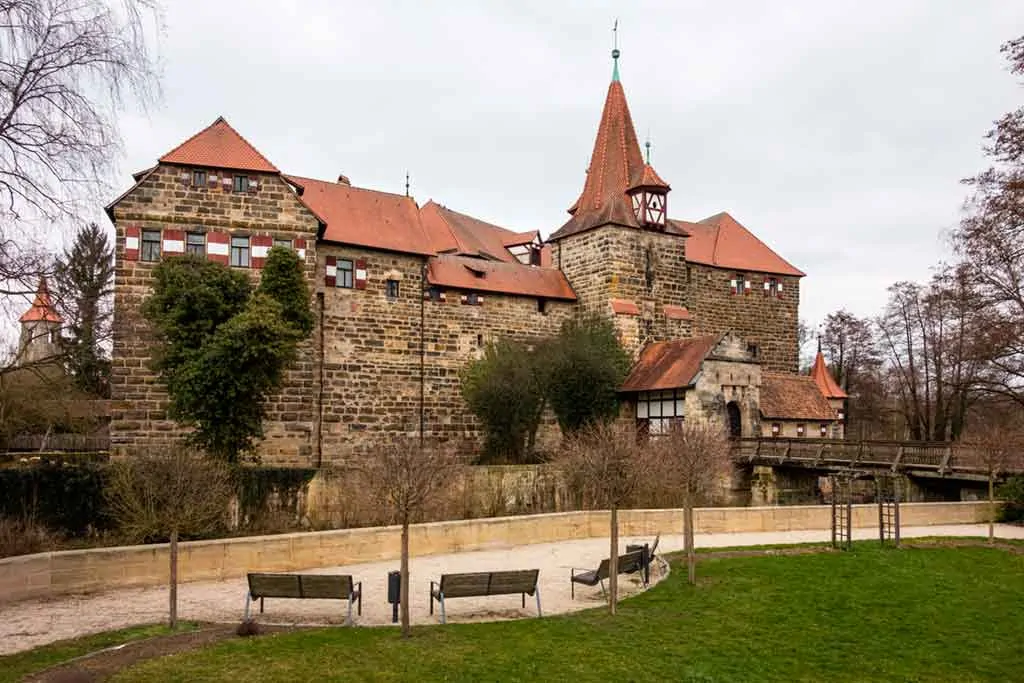
Located near Nuremberg in an area that was once part of the Bohemian crown lands, Lauf Castle was built by the Holy Roman Emperor Charles IV in the 14th century on the ruins of an older castle.
Shortly after construction, the Emperor ceded the castle to Otto V, Duke of Bavaria, during an exchange of lands. Today, the most impressive part of the castle is the hall of arms, discovered in 1934 when a layer of old paint was removed.
The 112 coats of arms found in the castle form a unique collection of heraldry belonging to the noblemen of the Crown of Bohemia.
Where: town of Lauf an der Pegnitz, near Nuremberg
When: 14th-century
Style: Medieval
Open to visit: No.
Tickets: –
13. Marienberg Fortress
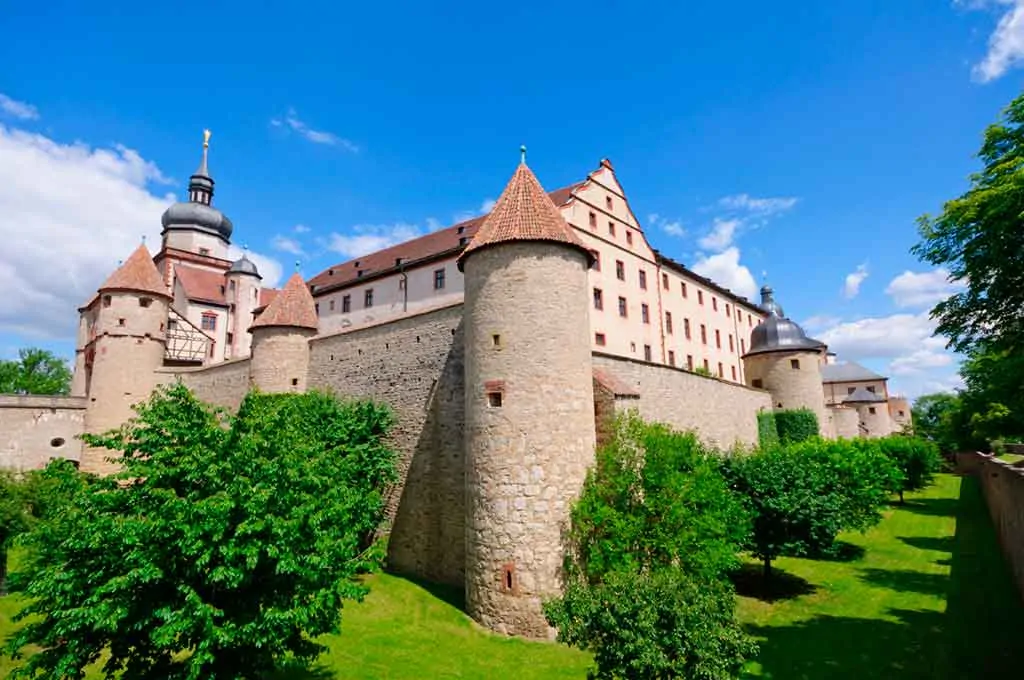
Built in the 12th century near the historic city of Wurzburg, Marienberg Fortress has witnessed centuries of turbulent history and was often under siege.
A swift attack left it severely damaged in the 17th century. Other significant damage followed during World War II when large parts of the fortress were destroyed by bombs.
The fortress was restored in the second half of the 20th century. One of the most unique attractions of the place is St Mary’s Church, a beautiful construction from AD 706.
Where: Wurzburg
When: 12th-century
Style: Early Medieval Fortress
Open for visit: Yes. Check here for more information.
14. Mespelbrunn Castle

Among the grandiose Bavarian castles, Melspelbrunn Castle is a unique sight. This is a small, incredibly romantic moated castle built near the end of the Middle Ages.
At the end of the 16th century, it was transformed from a typical medieval fortified structure into a manor house. Located in a deep valley and surrounded by forests and lush greenery, this remote castle belongs to the Counts of Ingelheim family, who live in one of the wings.
With its red sandstone walls and stained glass windows, Melspelbrunn Castle is one of the most original attractions in the region.
Where: Spessart Forest, Mespelbrunn
When: 15th– to 16th– centuries
Style: Late Medieval, Early Renaissance
Open for visit: Yes. For more information, check here.
15. Plassenburg
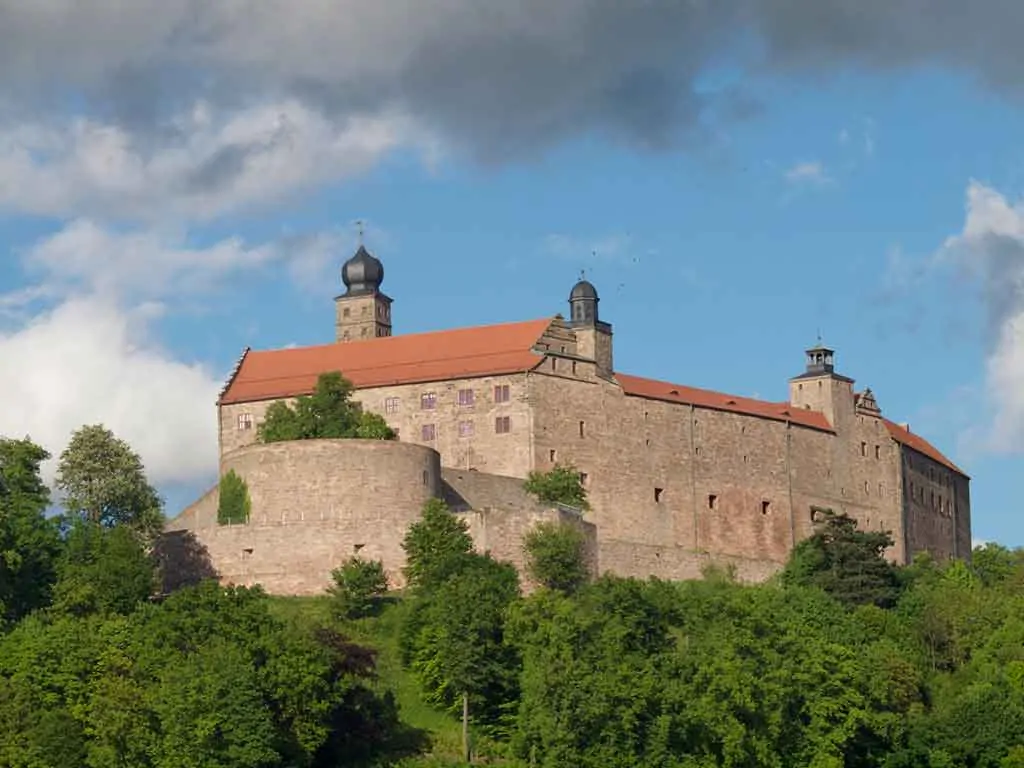
Situated high above the historic city of Kulmbach, Plassenburg is one of the best Bavarian castles to visit. Firstly mentioned in the 12th century, the castle was destroyed during war times in 16th century and then reconstructed.
The major attraction at Plassenburg is the impressive collection housed inside the castle: over 300,000 tin soldiers and figurines are set up to recreate battle scenes from various historical eras.
The castle also features a gorgeous arcaded courtyard of German Renaissance style.
Where: Kulmbach
When:12th-century/16th-century
Style: Medieval, German Renaissance
Open to visit: Yes, check here for more information.
16. Pottenstein Castle
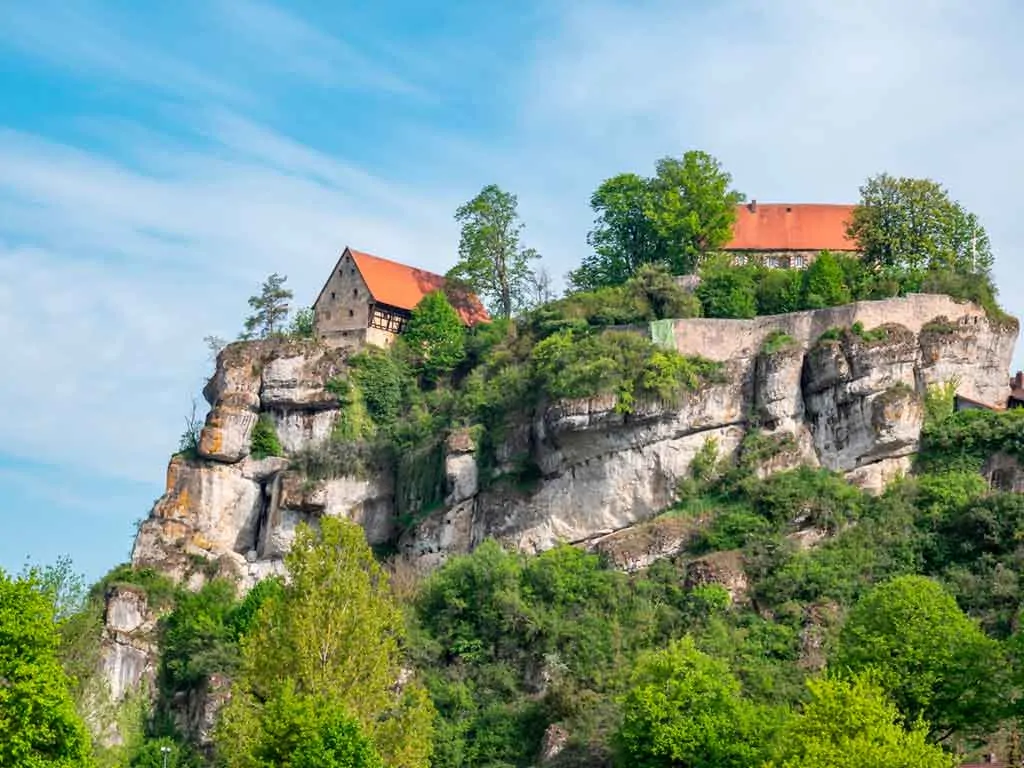
Standing majestically on a rock above the town of Pottenstein, Pottenstein Castle is one of the oldest castles in the region. Located within a forest nature park, this medieval castle belonged originally to the Count of Pottenstein, who lived in the 11th century.
Both the castle and the town of Pottenstein took part in many warlike events throughout the centuries, and as a consequence, the castle slowly fell into ruins.
At the beginning of the 20th century, it was purchased by the Baron of Wintzingerode, who dedicated himself to the renovation of the castle and the construction of a museum. The castle is now a privately-run museum and residence.
Where: Pottenstein, Upper Franconia
When: 11th-century
Style: Medieval
Open to visit: Yes, click here for more information.
17. Rothenberg Fortress
Rothenberg Fortress was built on the site of an older medieval castle mentioned for the first time in a document in 1254.
Although the exact time of the construction is unknown, other documents attest that the fortress belonged to the administrators of Nuremberg, then to Emperor Karl IV, King of Bohemia, and was eventually conquered by Bavarian troops during the Thirty Years’ War.
Despite heavy fortifications, the fortress was destroyed in battle. Although rebuilt, it never regained its military importance and was abandoned. The ruins are now a protected site.
Where: Schnaittach, Franconian Jura
When: 13th-century
Style: Medieval Fortress
Open to visit: Yes, Wednesday to Sunday from 10.00 am from April to October. Closed during the winter season.
Tickets: Adults – 5 euros; Reduced – 3 euros; Children under 4 – free
18. Schloss Egg
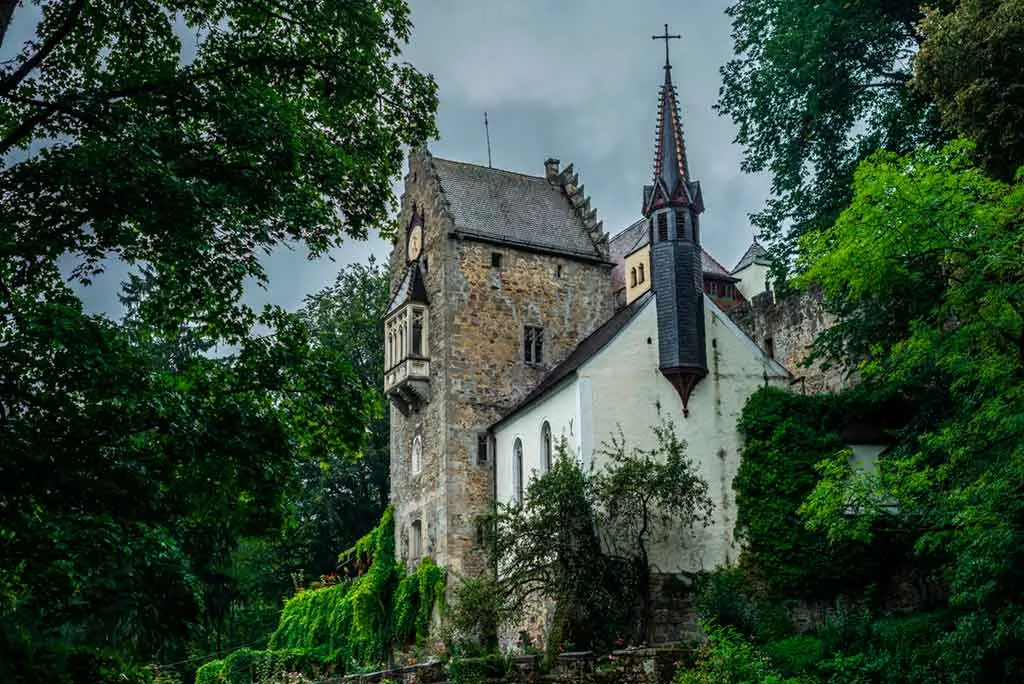
Built in the 11th century, Schloss Egg is a well-preserved medieval castle featuring the highest castle tower in Bavaria. The castle includes a former moat, a small chapel, a torture chamber, secret passages, bridges, gates, dungeons, and circular walls.
Although initially a fortress, the castle was transformed at the end of the Middle Ages in a comfortable and lavish residence. In the 19th century, the interiors were splendidly redecorated.
The gardens and the inner courtyards were also redesigned. The new Gothic elements blended with the earlier features into a unique design.
Where: Bernried
When: 11th-century/ 19th-century
Style: Medieval/ Neo-Gothic
Open to visit: Yes. Check here for more information.
19. Linderhof Palace
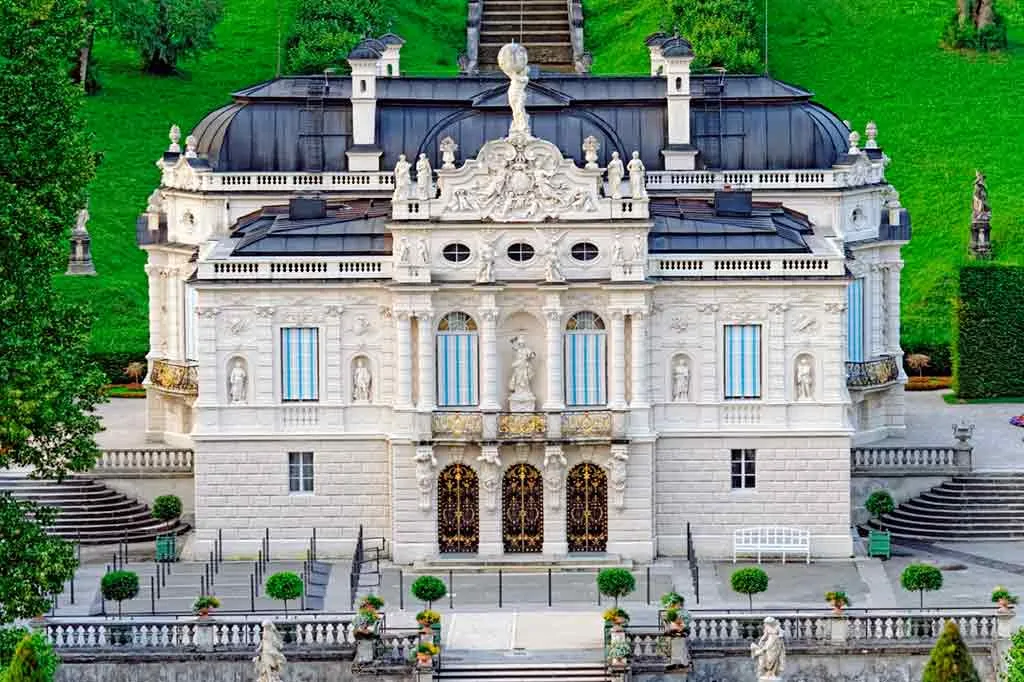
Built at the request of eccentric King Ludwig II whose imagination stood behind the construction of the magnificent Neuschwanstein and Herrenchiemsee castles, Linderhof is undoubtedly one of the top sights in Bavaria.
Built in the style of 19th-century French castles, this spectacular Baroque building is also known as the Little Versailles. The interiors feature lavish furniture and decorations.
Outside, beautiful fountains, lawns, and symmetric flower arrangements form a charming landscape.
Where: Graswang Valley, the village of Ettal
When: 19th-century
Style: Baroque
Open for visit: Yes, check here for more information.
20. Herrenchiemsee New Palace
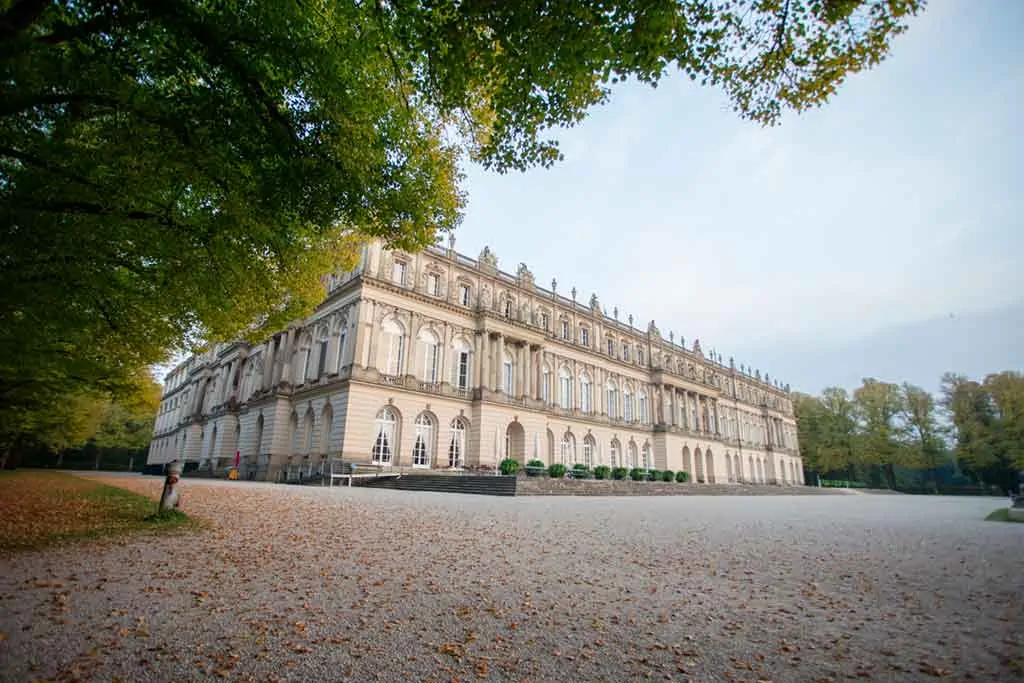
With its architectural splendor and unique location, Herrenchiemsee Castle is one of the best castles in Bavaria to visit. Lying on the island of Herreninsel on Chiemsee Lake, this remote castle is only accessible by boat.
The history of the castle began in 1873 when King Ludwig II acquired the island and decided to build a palace on the model of Versailles, the royal residence of the French King Louis XIV.
The castle features a Great Hall of Mirrors, just like Versailles. On the island, visitors can also check out a historical Augustinian Monastery, which includes a museum and two art galleries. Boat tours across the lake are also available.
Where: Herrenchiemsee, Lake Chiemsee
When: 19th-century
Style: Baroque
Open for visit: Yes, check here for more information.
21. Nymphenburg Palace
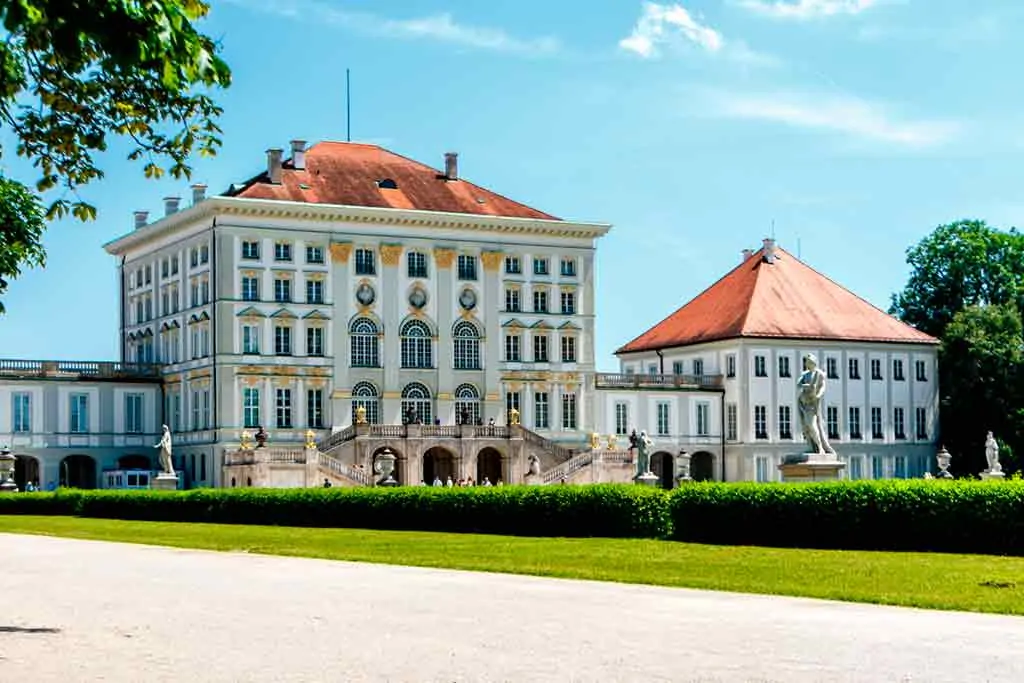
Nymphenburg Palace is a stunning Baroque building whose construction began in 1664 and ended a century and a half later. Located in Munich, Bavaria’s largest city, this sprawling palace was built to serve as a summer residence for the Bavarian electors.
Since the castle was built gradually over time and redesigned several times, it ended up incorporating several architectural styles. The façade is original, and also the furnishings and furniture in the grandiose rooms.
The top features of the castle include the beautiful gardens split by a canal and the porcelain museum on the grounds.
Where: Munich
When: 17th– to 19th– centuries
Style: Baroque, Neoclassical, Rococo
Open for visit: Yes. Check here for more information.
22. Schleissheim Palace
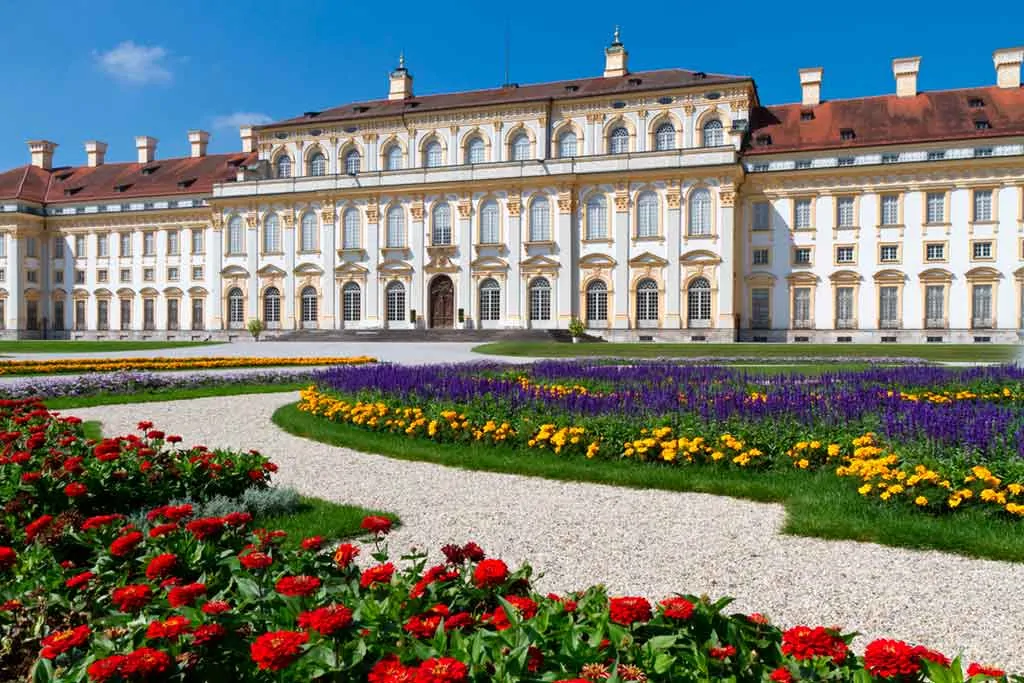
Located just north of Munich, Schleissheim Palace is actually a complex of three different buildings. The Old Palace is a 14th-century Renaissance country house near which the Lustheim Palace, an Italian-style garden villa, was added in the 15th century.
This second construction was followed by a third in the 16th century, which is the New Palace, a charming Baroque chateau. The three palaces are united by open gardens and surrounded by an intricate canal network.
The interiors include beautiful artworks, porcelains, and period furniture in their collections. A beer garden also functions on the grounds.
Where: Oberschleißheim, north of Munich
When: 14th-, 15th- & 16th- centuries
Style: Renaissance, Italian, Baroque
Open to visit: Yes, check here for more information.
23. Lauenstein Castle
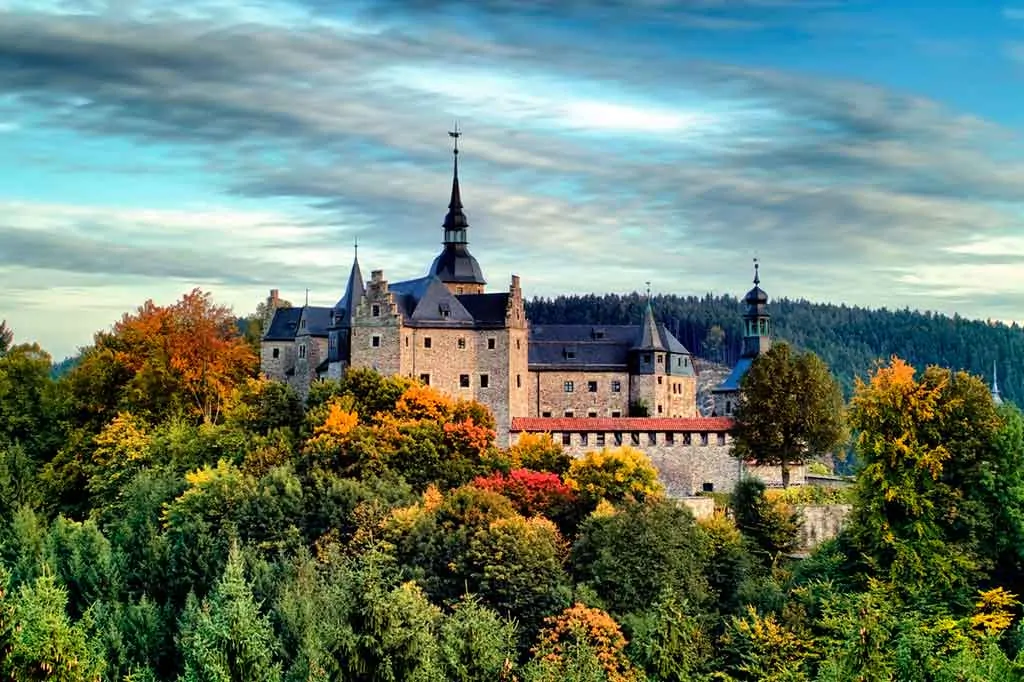
The history of Lauenstein Castle begins in the 12th century. For the following two centuries, the castle served as the seat of the Orlamunde, a powerful noble family of counts.
With the decline of the family, the castle lost its importance and changed owners several times. In the 16th century, the Lords of Thyna built a new wing inspired by the Renaissance palace architecture popular at the time.
After a period of neglect, a new owner ran a restoration project and added new Historicist architectural elements. The castle is now fully restored and houses a museum of medieval armor, weaponry, paintings, and furniture.
Where: Ludwigsstadt
When: 12th-century
Style: Renaissance/Late Historicist
Open to visit: Yes, check here for more information.
24. Prunn Castle
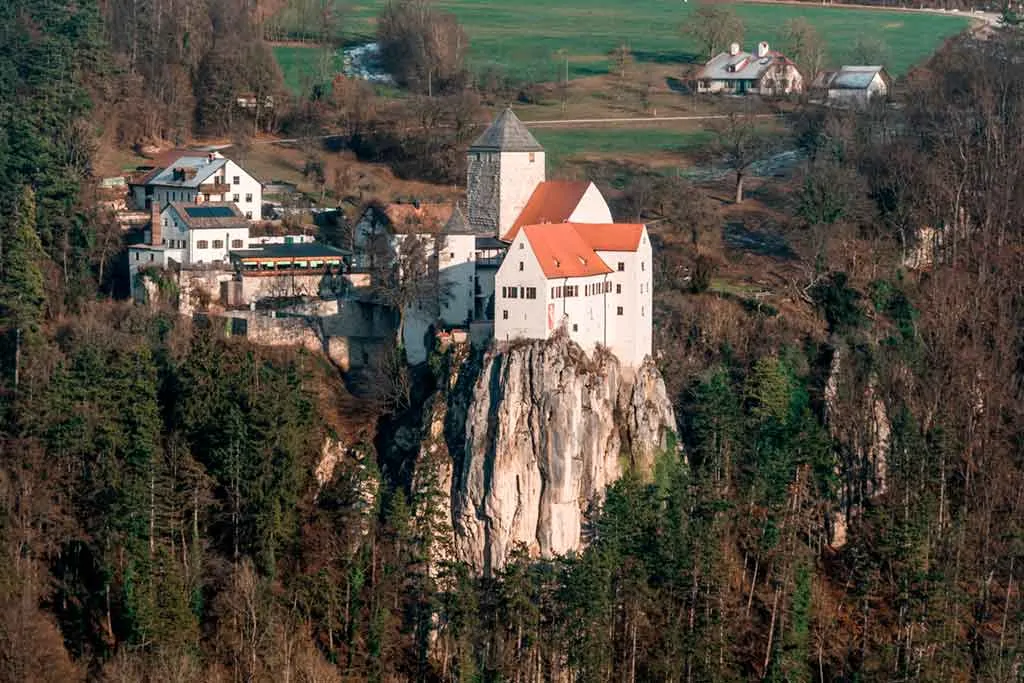
Prunn Castle was built in the early 13th century, and it’s a beautiful example of the Gothic style. If the architecture of the place is charming, the location is even more entrancing.
The castle is located on an outcrop overlooking the Altmuhl River Valley, with the river just below. Besides the spectacular views from within the walls, the castle is worth a visit for its original medieval décor.
A large Gothic-style hall has remained intact since the 13th century. The collections of the museum also include the Prunner Codex, the historical manuscript of a popular German folk tale.
Where: town of Riedenburg, Kelheim
When: 13th-century
Style: Gothic
Open to visit: Yes, check here for more information.
25. Coburg Fortress
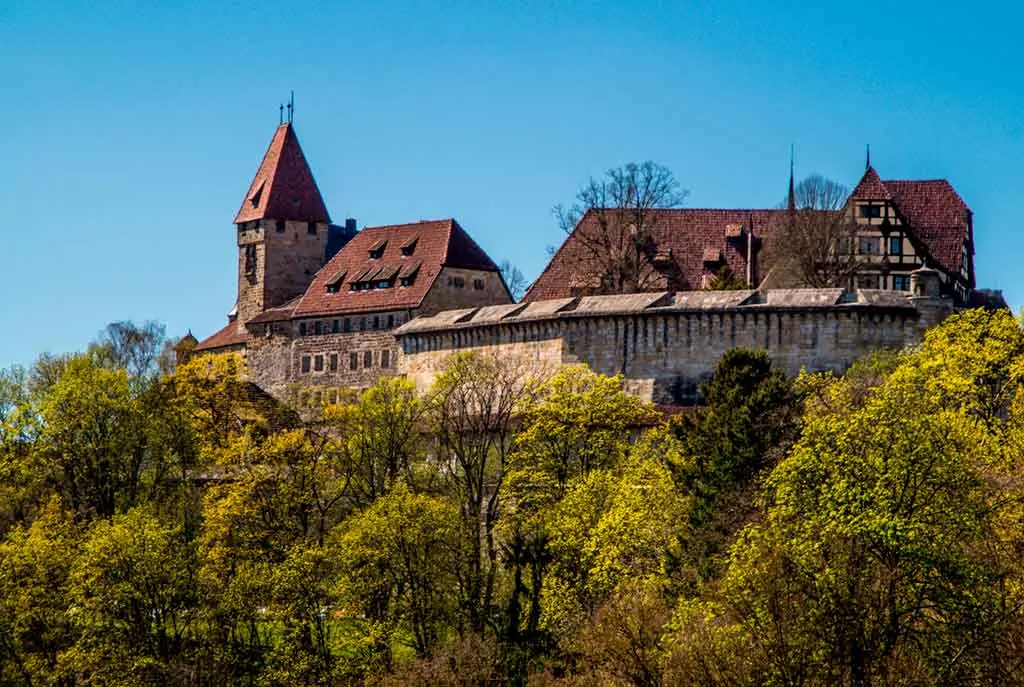
Documents suggest that Coburg Fortress was built in the 11th century and had an important strategic value.
In the 14th century, it entered the possession of the powerful House of Wettin and was gradually enlarged over the next century, eventually becoming one of the largest castles in Bavaria.
In the 18th century, the castle was renovated according to the Neo-Gothic style. Today, it is home to one of the most important collections of art pieces and historical artifacts in Germany.
This includes many treasures, from hunting weapons to paintings by German masters.
Where: Coburg
When: 11th-century/18th-century
Style: Medieval/Neo-Gothic
Open to visit: Yes, check here for more information.
26. Ansbach Residence
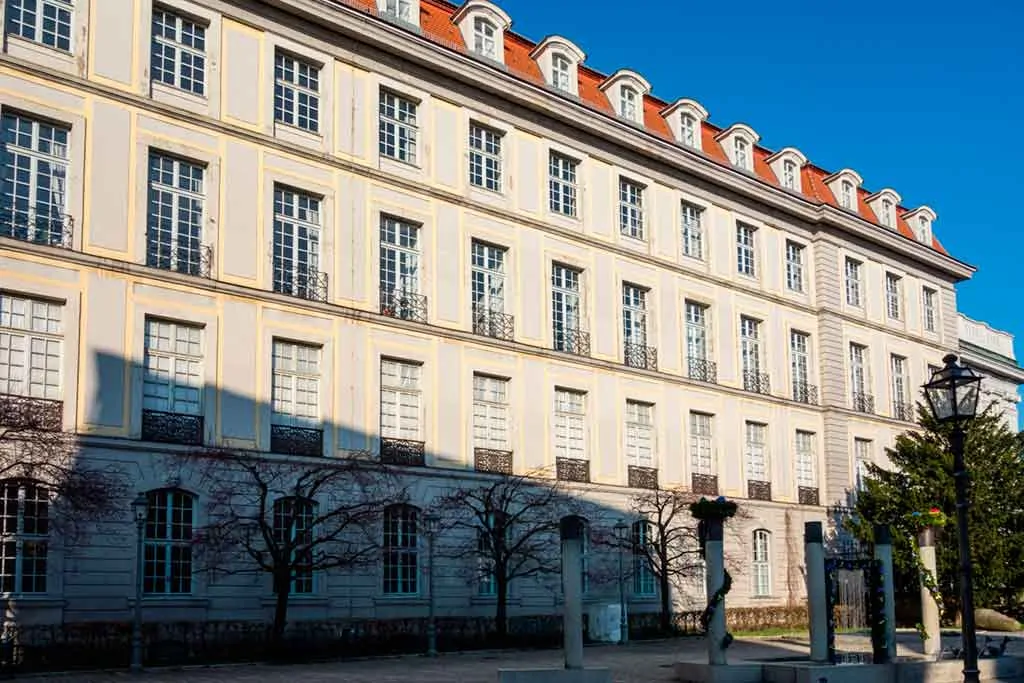
Ansbach Palace is one of the top castles in Bavaria to visit, as it has remained intact since the 18th century.
Expanded from an earlier medieval complex, the castle features an impressive ceiling painting in the Festival Hall and a beautiful Mirror Cabinet.
The Gothic Hall is the main remaining part of the medieval building and is home to a ceramic collection. On the grounds of the castle, visitors can stroll through a charming orangery and herb garden.
Where: Ansbach, Middle Franconia
When: 14th– century to 18th-century
Style: Renaissance
Open to visit: Yes, check here for more information.
27. Seehof Palace
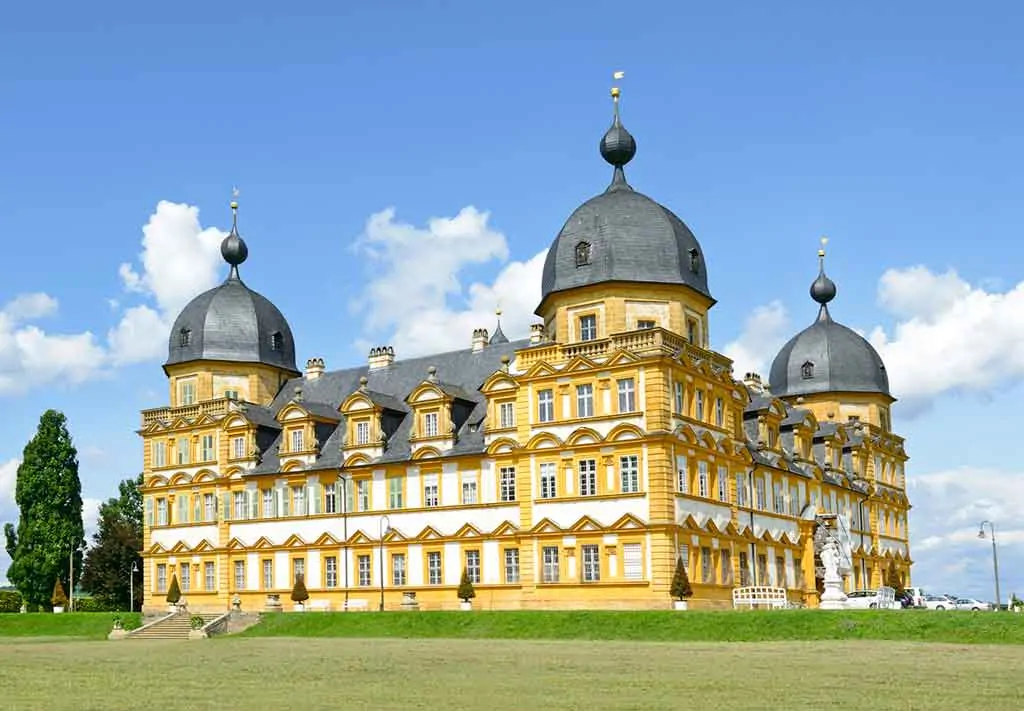
The construction of the Seehof Palace began in 1686, and the castle was built as a summer residence for the Bamberg Prince-Bishops.
After the secularization of the country, the castle passed into private ownership but was heavily neglected and fell into ruins.
Extensive renovation work rehabilitated the castle at the end of the 20th century. The Prince-Bishops’ apartments are open to the public.
Where: Memmelsdorf, Bamberg, Upper Franconia
When: 17th-century
Style: Baroque
Open to visit: Yes, check here for more information.
28. Cadolzburg Castle
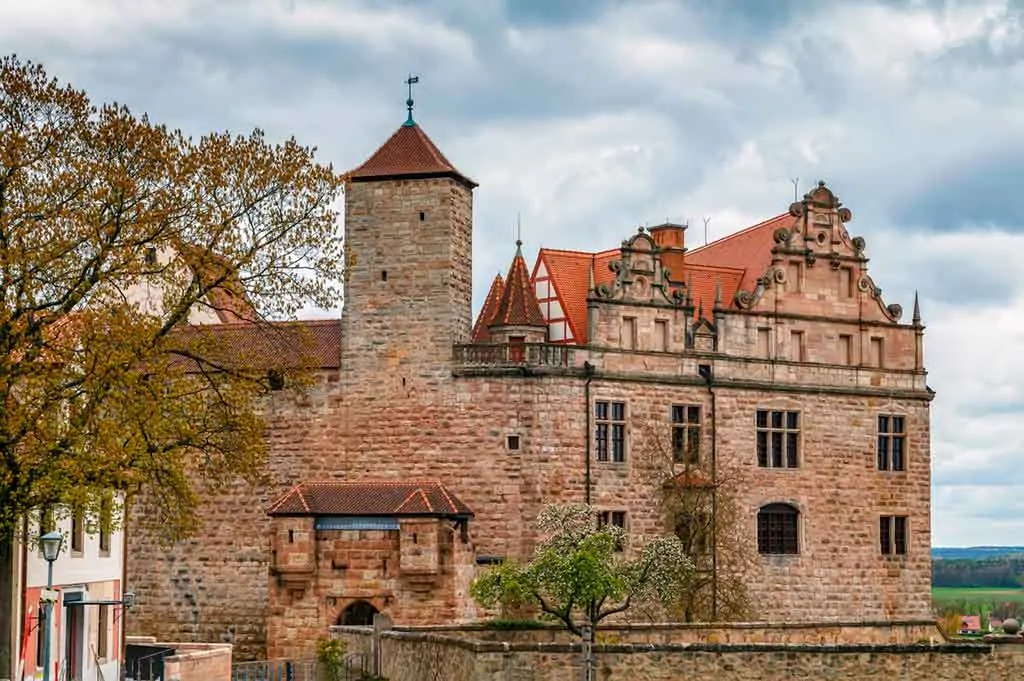
A historic document mentions Cadolzburg Castle as early as 1157. This makes the castle one of the oldest in Bavaria.
The castle was inhabited from the mid-13th-century onwards by members of the Hohenzollern dynasty of kings, emperors, and electors, which put the castle at the forefront of many historical events.
Full of fascinating history, Cadolzburg offers an immersive experience into a forgotten era.
Where: Cadolzburg, Furth, Middle Franconia
When: 12th-century
Style: Medieval
Open to visit: Yes, check here for more information.
29. Willibaldsburg Castle
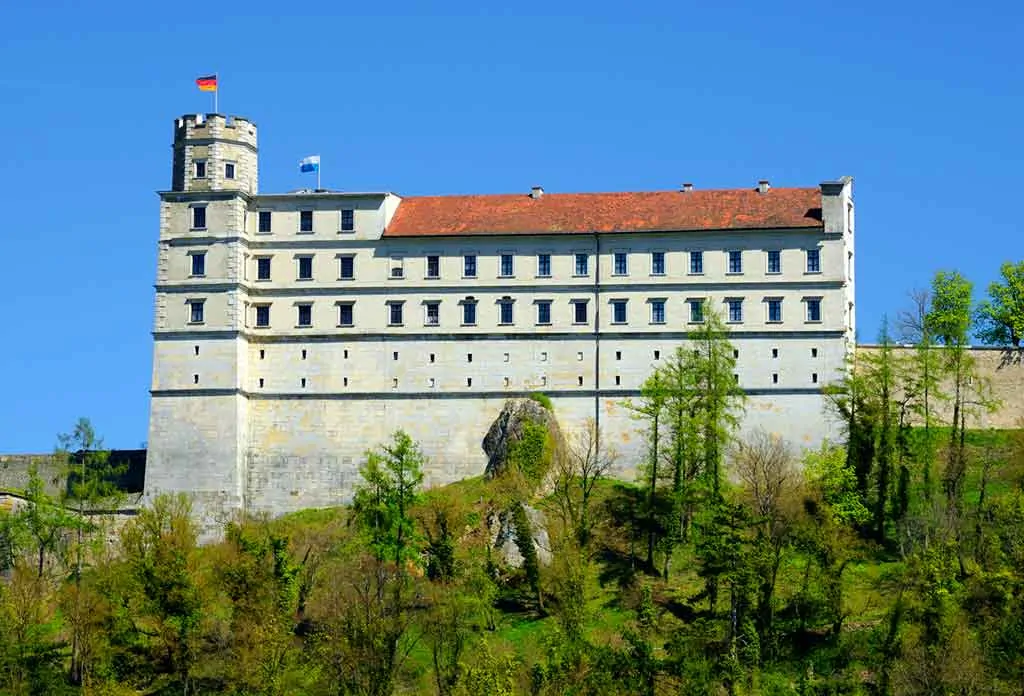
Willibadlsburg Castle is a large castle complex whose construction began in the 14th century. It was largely expanded and fortified in the 16th century to become a lavish residence for the Prince-Bishop.
The castle served as the main residence and seat of Eichstatt’s prince-bishops up until the middle of the 18th century. A world-class botanical garden has existed on the grounds for a long time.
In 1998, this original botanical garden was reproduced by a newly opened Bastion Garden.
Where: Eichstatt, Upper Bavaria
When: 14th-century
Style: Medieval
Open to visit: Yes, click here for more information.
30. Trausnitz Castle
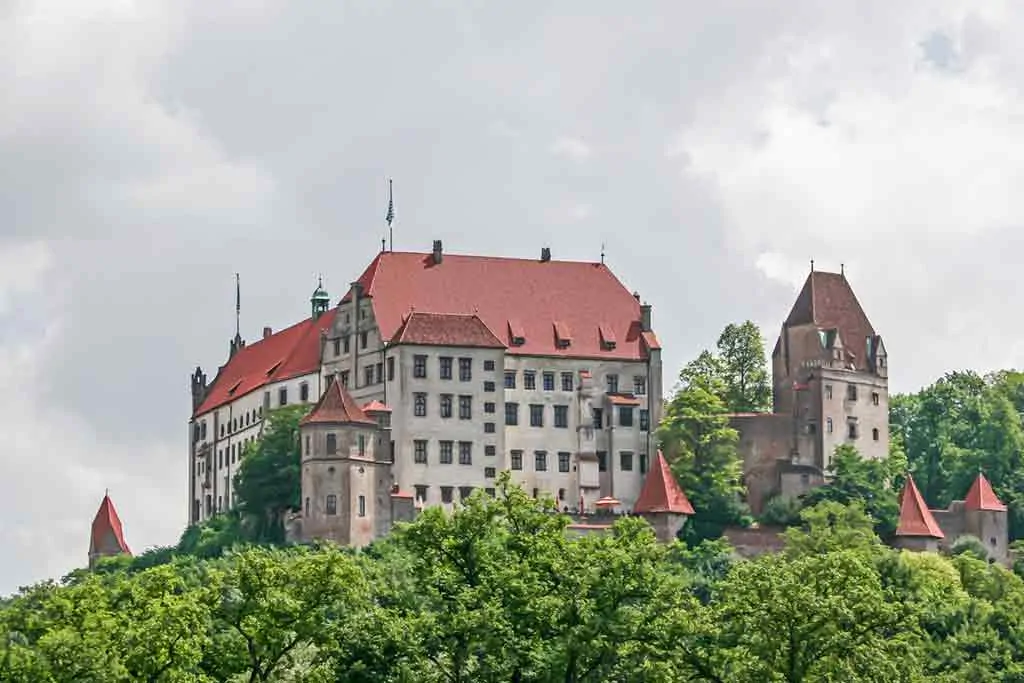
Trausnitz Castle is a 13th-century construction located in the charming Bavarian town of Landshut. The castle served as the seat of the Bavarian monarchy for many centuries, having an important political and military role.
Due to its importance, it was repeatedly redesigned and redecorated to reflect the trends of the era. Major upgrades date back to the 19th century when the castle was turned into an opulent residence.
Top features of the castle are the Knights Hall, the White Hall, and the Tower Terrace, which offers stunning views over the town below.
Where: town of Landshut, northeast of Munich
When: 13th-century
Style: Medieval/German Renaissance
Open to visit: Yes, check here for more information.
31. Neuburg Palace
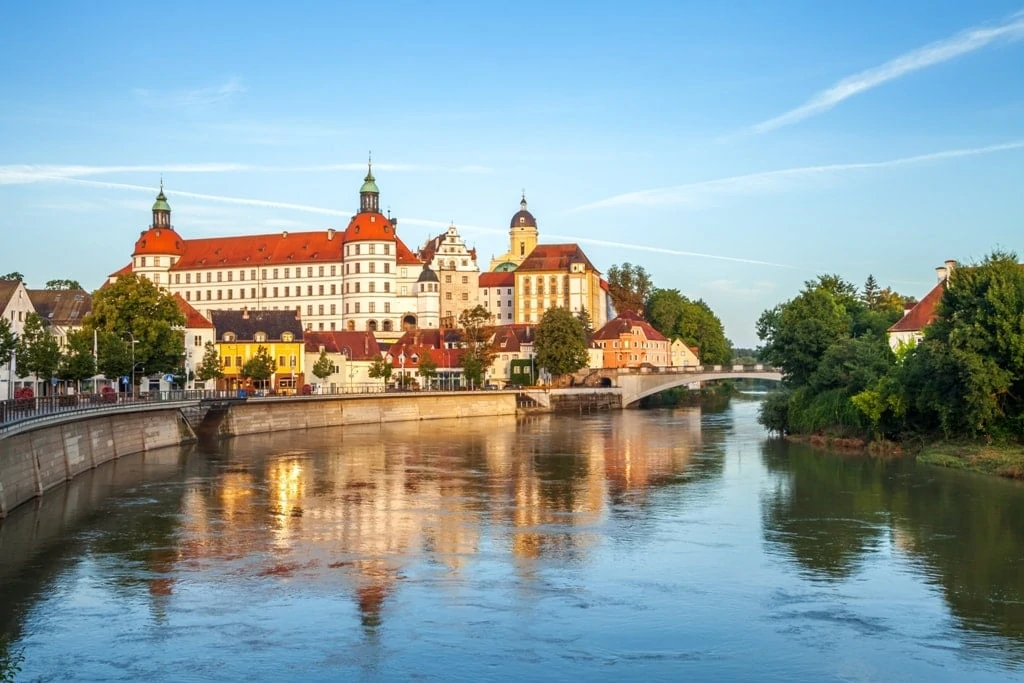
Neuburg Palace is a Renaissance palace built in the 16th century to serve as the seat of the principality of Pfalz-Neuburg. It was expanded in the next century with two round towers that added an imposing look to the original baroque look.
The castle features a decorated courtyard, several Baroque grottoes, and a beautiful Renaissance Knights’ Hall. A chapel with medieval frescoes is part of the complex.
Due to its importance in the history of the principality, the castle is home to a large collection of paintings, tapestries, weapons, furniture, portraits, and textiles that reflect the rich culture of the place.
Where: Neuburg/Donau
When: 16th-century
Style: Medieval/Baroque/Renaissance
Open to visit: Yes, check here for more information.
32. Rosenburg Castle
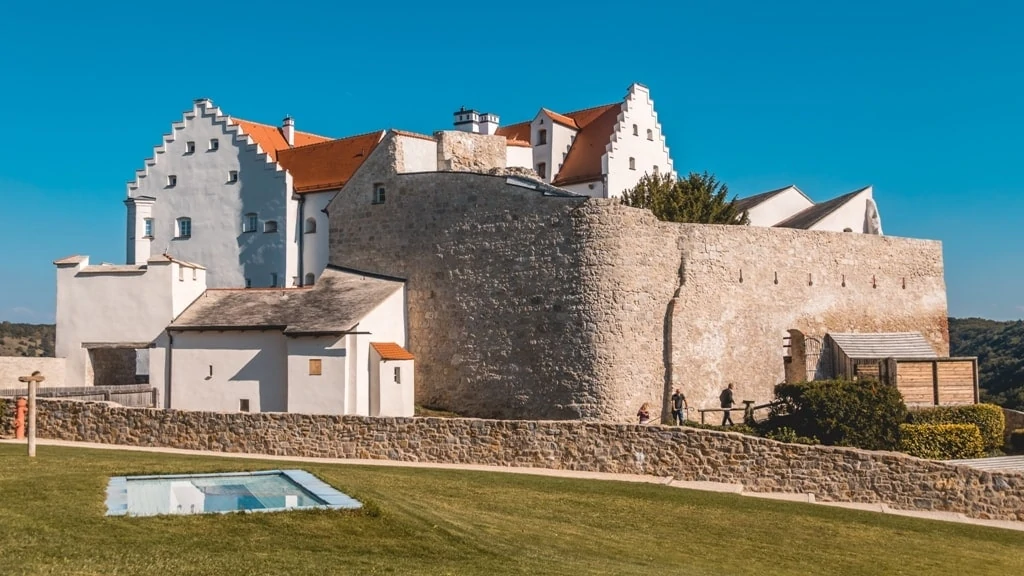
Built in the middle of the 12th century, Rosenburg Castle entered the possession of the Dukes of Bavaria a few decades after construction. Since then, it has remained in the ownership of the House of Wittelsbach.
Although twice destroyed and rebuilt, the castle has remained largely Romanesque in style. Its present appearance dates from 1525 and showcases elements of the South German Renaissance.
The Museum of Hunting and Falconry gives regular demonstrations at the castle.
Where: Riedenburg, Kelheim
When: 12th-century
Style: Renaissance/Romanesque
Open to visit: Yes, check here for more information.
Bavaria has always been at the forefront of European history, which explains the impressive number of castles, palaces, and medieval fortresses that dot the region.
However, its beautiful nature and lush landscapes make these architectural treasures stand out as places of incredible Romantic charm. If you visit Bavarian castles, you get immersed in a world made of legend and aristocratic splendor.
FAQ about the best castles in Bavaria, Germany
There are many beautiful castles in Bavaria, so it is hard to choose which is the most beautiful castle in Bavaria, Germany. One of the most beautiful castles, as well as the most famous castle, is Neuschwanstein Castle, followed by Linderhof Palace. Burghausen Castle, the largest castle in the world, is also one of the most beautiful castles in Bavaria to visit.
The Bavarian castles were built by different noble families. One, who stood out, was King Ludwig II of Bavaria. He created some of the most famous and modern castles of its time, like Neuschwanstein Castle or Linderhof Palace.
The must-see castles in Bavaria, Germany, are Neuschwanstein Castle, Linderhof Palace, Wurzburg Residence, Melspelsbrunn Castle, and Schleissheim Palace.
You might also be interested in: The beautiful Burg Eltz in Germany.
PIN IT!
